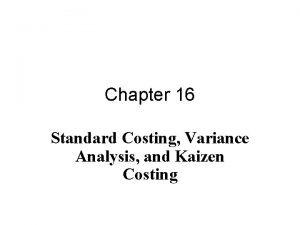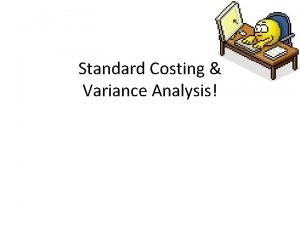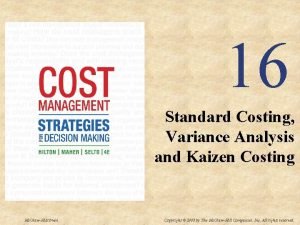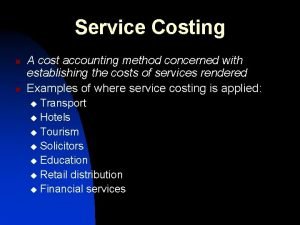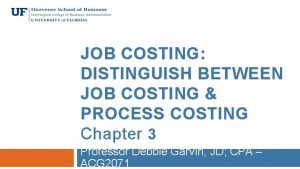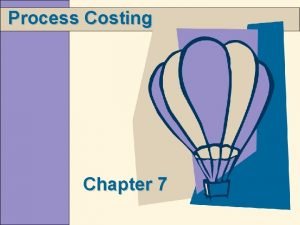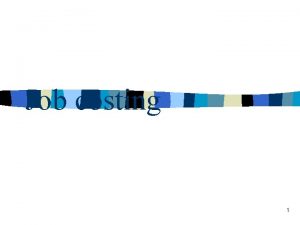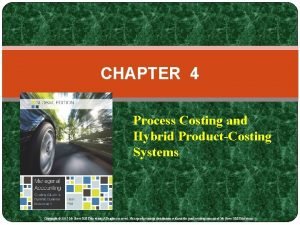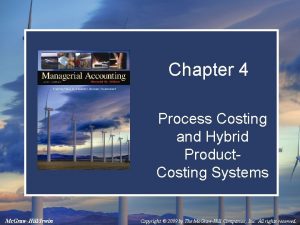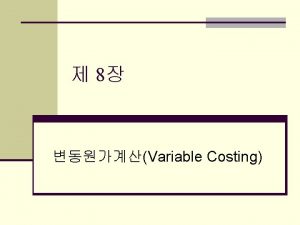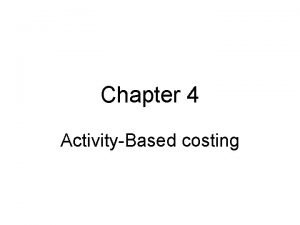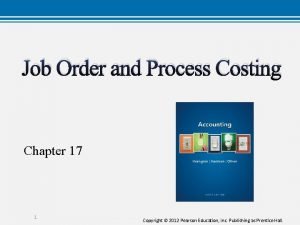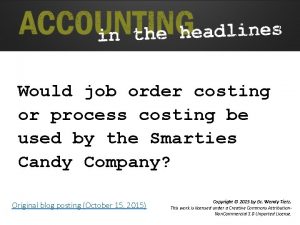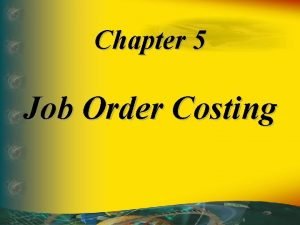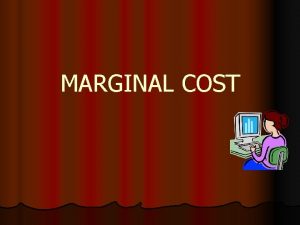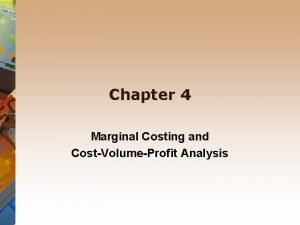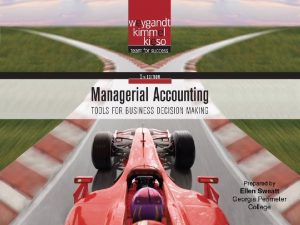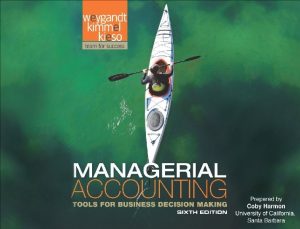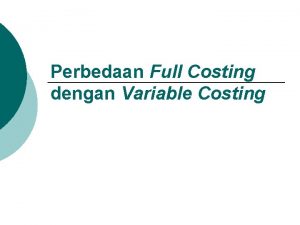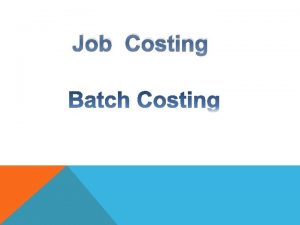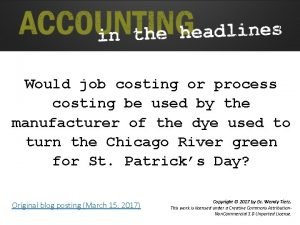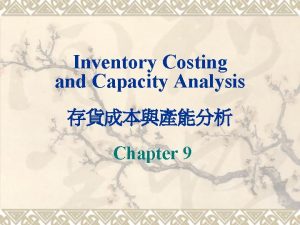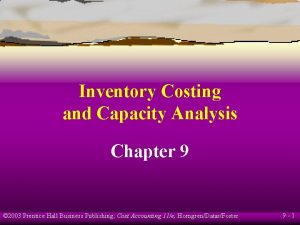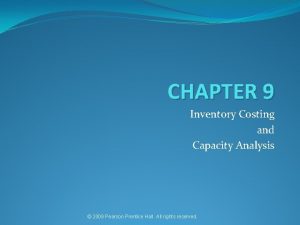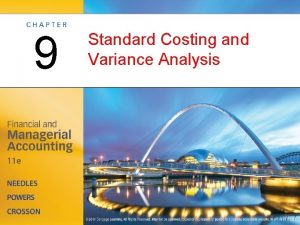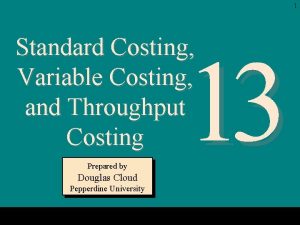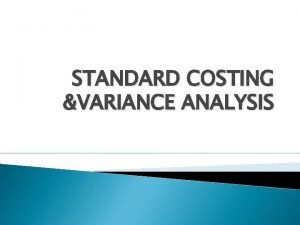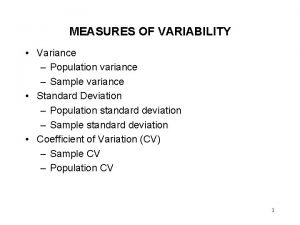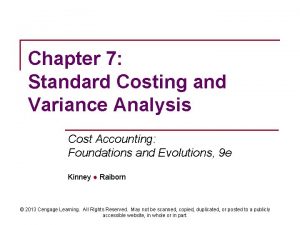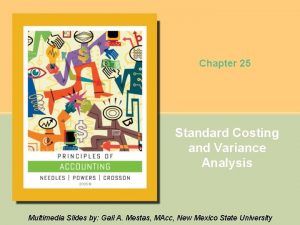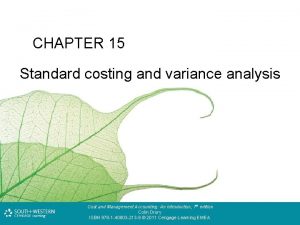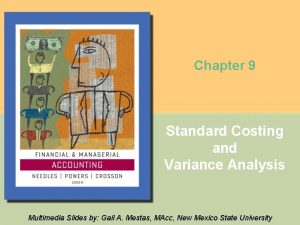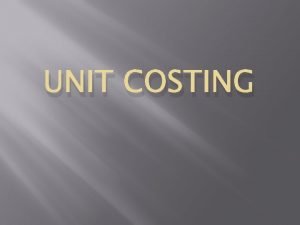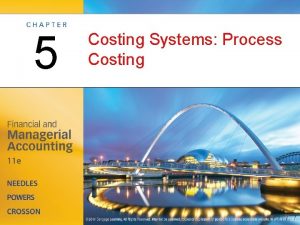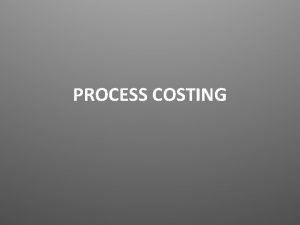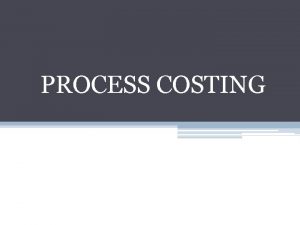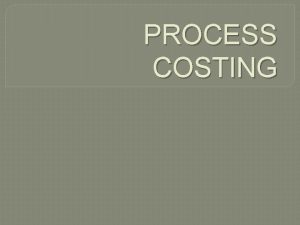Chapter 11 Standard Costing and Variance Analysis Standard

































- Slides: 33

Chapter 11 Standard Costing and Variance Analysis

Standard costing is a system where preset standards are used in the estimation of costs. This can provide more detailed variance analysis information for managers. It involves the setting of detailed predetermined standard product costs, so that a business can accurately estimate, based on the standards set, what the cost of a product or service should be. Comparing this standard to the actual cost of a product enhances cost control.

Standard cost ‘Benchmark measurement of resource usage or revenue or profit generation, set in defined conditions’. Standard cost as defined by CIMA Official Terminology A standard cost is a predetermined calculation of what a cost should be under specified working conditions. Setting a standard involves the establishment of two components for each cost type, the volume required and the unit cost attached to that volume.

Variance analysis ‘Evaluation of performance by a means of variances, whose timely reporting should maximise the opportunity for managerial action’ Variance analysis as defined by CIMA Official Terminology

Budgetary control worksheet

Budgetary control reconciliation

Direct materials variance The materials variance of € 3, 000 adverse could be further analysed into its two component parts: Materials price variance: This variance reflects the difference between the actual purchase price of materials (food) and the standard purchase price set. Materials usage variance: This variance reflects the difference between the actual quantity of materials used and the quantity allowed, for the various products produced.

Direct labour variance The direct labour variance of € 3, 000 favourable could be further analysed into its two component parts: Labour rate variance: This is caused by differences between the actual labour rate and the standard rate set in the budget. Labour efficiency variance: This is due to the differences between the actual time spent in producing the products and the standard time allowed or set in the budget.

Overhead variances The variable overhead variance of € 2, 000 adverse could be further analysed into its two component parts: Rate: Caused by the difference between the actual variable overhead rate and the budgeted rate. Efficiency: Caused by the difference between the actual variable overhead usage and the standard usage allowed in the budget. The fixed overhead variance of € 3, 000 adverse Standards are not normally set for fixed overhead because they are a product of time and not of efficiency or production.

Summary of variances

Key variances in standard costing Direct material variances

Key variances in standard costing Direct labour variances

Key variances in standard costing Variable overhead variances

Example 11. 1: Standard costing

a) Calculate the standard variable cost of a single souvenir unit

b) Prepare a worksheet showing the fixed budget, flexible budget, actual results and variance for the period

c) Further analyse the materials, labour and overhead variances into the following sub-variances

c) Further analyse the materials, labour and overhead variances into the following sub-variances

c) Further analyse the materials, labour and overhead variances into the following sub-variances

c) Further analyse the materials, labour and overhead variances into the following sub-variances

c) Further analyse the materials, labour and overhead variances into the following sub-variances

c) Further analyse the materials, labour and overhead variances into the following sub-variances

c) Further analyse the materials, labour and overhead variances into the following sub-variances

d) Prepare a statement reconciling the budgeted net profit with actual net profit

Interpretation of Variances Materials Price € 1543 F Possible reasons Availing of quantity discounts General reduction in price of raw materials Materials usage € 40 A Possible reasons Purchase of poor quality materials Quality/age of equipment used leading to greater waste Poor labour efficiency leading to greater waste Accuracy of standard Theft

Interpretation of Variances Labour rate Labour efficiency € 630 A € 500 A Possible reasons Unexpected wage deal that applied retrospectively. Out of date standard. Increase in overtime. Increase in labour taxes. Possible reasons Skill and training of staff. Motivational factors such as working conditions, pay, career prospects. Quality of materials. Quality and age of equipment. Accuracy of standard.

Interpretation of Variances Variable O/H rate € 293 F Variable O/H Efficiency € 100 A Possible reasons Standard not reviewed regularly Fall in the rate This variance is related to the labour efficiency variance and is influenced by the same factors that influence the labour efficiency variance.

Summary of reasons for variances Materials Price Changes in market price between the agreeing of standards and actual performance. Poor performance by the purchasing department staff in not achieving better value purchasing. Unrealistic standards not regularly reviewed. Materials Usage Poor quality materials purchased, leading to high levels of waste. Faulty equipment leading to higher levels of waste. Poor levels of labour efficiency. Unrealistic standards not reviewed. Labour Rate Standard not reflecting changing rates of pay. Unanticipated increases in overtime levels. Unanticipated increases in labour taxes (employers PRSI). Labour Efficiency Poor staff motivation. High staff turnover and hence an increase in staff training. Poor quality materials. Faulty equipment. Delays in material supplies resulting in wasted labour time.

Interrelationship of variances The purchase of cheap and inferior materials will lead to a favourable materials price variance but can cause an adverse materials usage variance, due to increased waste associated with the inferior materials. It can also lead to an adverse labour efficiency variance as employees may require added time as a result of the inferior materials. Cheaper labour costs will lead to a favourable labour rate variance but can cause an adverse labour efficiency variance due to the requirement for training and the effects of the learning curve. This can also cause an adverse materials usage variance. Adverse labour efficiency variances can also create adverse variable overhead efficiency variances Not reinvesting in equipment can create favourable capital spending variances, however this can lead to adverse variances in materials usage, labour efficiency and variable overhead.

The standard setting process Crucial to a system of standard costing is the setting of standard costs that can be used as a benchmark against which actual performance can be measured. Before a system of standard costing can be implemented, a range of information must be collected from various departments to be analysed. Examples would include: Purchasing costs of direct materials from the purchasing department. Wage rates and productivity agreements from the personnel department. Details of overhead costs from the accounting / production department.

The standard setting process Direct materials standard costs Standard price – based on prices agreed and negotiated with supplier (average price the firm expects to pay during the life of the standard) Standard usage - based on product specifications allowing for unavoidable losses. Direct labour standard costs Standard rate – the wage rate as agreed in any trade union agreement. Standard efficiency – the average time a direct labour employee takes to perform tasks related to a unit of production. Variable production overhead standard costs Variable overhead rate standard – based on historic information about variable overhead costs. Variable overhead efficiency standard – is generally either direct labour hours or direct machine hours.

The standard setting process Standards should be attainable and should not assume perfect or ideal conditions. Built into any standard should be certain allowances for what is termed 'normal loss'. Standards, although realistic and with allowances built in, should also have a motivating affect on employees. Employees must be involved in the standard setting process where it affects them, especially in terms of the efficiency standards. In setting standards, management must accept and anticipate some degree of variability between actual performance and the standard set. Standards should to be revised to ensure they are still realistic.

Advantages of standard costing More accurate pricing of products based on detailed cost analysis. Carefully planned standards are an aid to more accurate budgeting. The business will have a more simplified stock control system, as all materials purchased are valued at standard cost rather than LIFO or FIFO value systems. More detailed variance analysis leading to a deeper level of investigation and better management decision-making. A target of efficiency is set for employees and cost consciousness is stimulated. The setting of standards involves determining the best materials and practices, which may lead to economies. An overall improvement in the financial control of the business.
 Standard costing and variance analysis formulas
Standard costing and variance analysis formulas Variance analysis meaning
Variance analysis meaning Standard costing and variance analysis
Standard costing and variance analysis Standard costing and variance analysis
Standard costing and variance analysis Kaizen costing
Kaizen costing Objective of standard costing
Objective of standard costing Difference between service costing and output costing
Difference between service costing and output costing Distinguish between job costing and process costing
Distinguish between job costing and process costing Difference between job costing and contract costing
Difference between job costing and contract costing Job order cost system
Job order cost system Process costing and hybrid product-costing systems
Process costing and hybrid product-costing systems Wip control account
Wip control account Hybrid costing example
Hybrid costing example Cost of production report
Cost of production report Job order vs process costing
Job order vs process costing Mixed cost
Mixed cost Target costing and activity based costing
Target costing and activity based costing Job order costing
Job order costing Job costing with process costing
Job costing with process costing Companies that use job order costing
Companies that use job order costing Katherine company manufactures special machines
Katherine company manufactures special machines Absorption costing vs marginal costing
Absorption costing vs marginal costing Variable costing vs absorption costing
Variable costing vs absorption costing Desired sales formula
Desired sales formula Abc costing vs traditional costing
Abc costing vs traditional costing Advantages of activity based costing
Advantages of activity based costing Activity based costing vs job costing
Activity based costing vs job costing Perbedaan full costing dan variable costing
Perbedaan full costing dan variable costing Objectives of job costing
Objectives of job costing Contoh full costing dan variable costing
Contoh full costing dan variable costing Job costing vs process costing
Job costing vs process costing Chapter 9 inventory costing and capacity analysis
Chapter 9 inventory costing and capacity analysis Chapter 9 inventory costing and capacity analysis
Chapter 9 inventory costing and capacity analysis Inventory costing and capacity analysis
Inventory costing and capacity analysis
